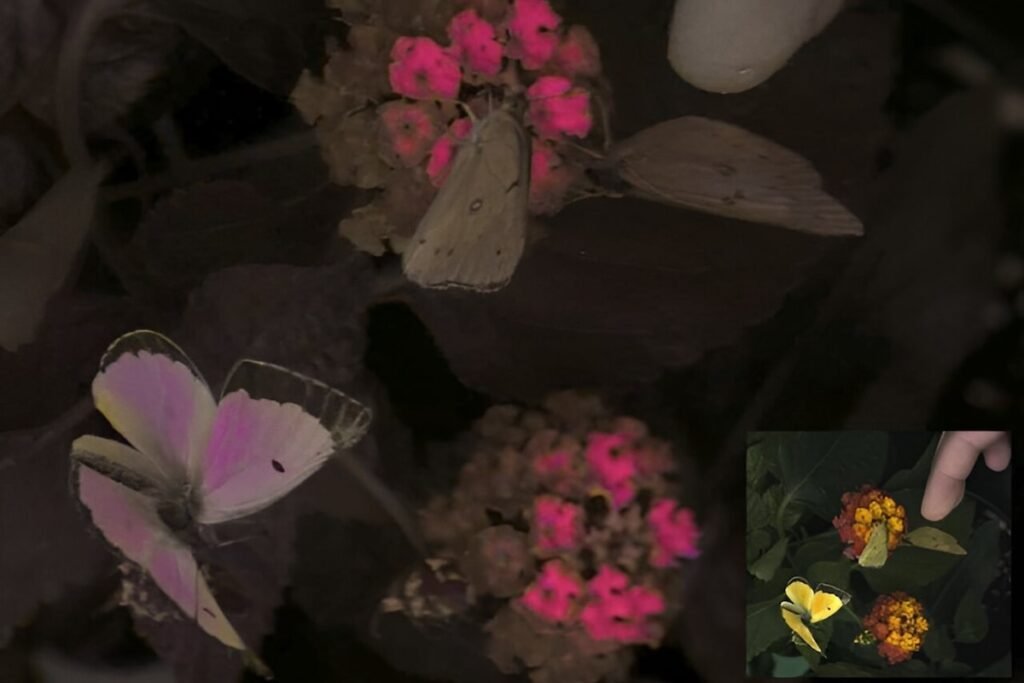Scientists and collaborators at George Mason University have announced a new camera system and software package that allows both researchers and filmmakers to capture and display animal perspective video.Daniel Hanley/George Mason University
What would it be like to see the world through the eyes of a bird, dog, or insect?
An international team of researchers aims to provide answers by building a video camera system that captures how different animals perceive color and displays it in a way that human viewers can experience. I took a step.
The results reveal hidden cues that guide animals, who have visual systems quite different from ours, and could indicate not just what they see, but what they’re likely to pay attention to. said the researchers.
A description of the camera system and examples of its performance are as follows. published last week Published in PLOS Biology journal.
“We can accurately record color in motion, something we haven’t been able to do before,” said Daniel Hanley, a sensory ecologist at George Mason University in Fairfax, Virginia, who co-led the effort. Told.
He said the idea for the camera began more than a decade ago as a postdoctoral researcher at the University of Guelph in Ontario, where he collaborated with Peter Kevan, now a professor emeritus and an expert on the biology of bees and other pollinators. He was born when he was
Dr. Kevan’s previous research into bee vision included building a repository of photographs of flowers taken through various color filters. By digitally scanning and combining these images, patterns invisible to the human eye can emerge. However, such approaches ignore subtle changes that occur when objects are viewed from different angles and lighting conditions.
In conversations with Dr. Kevan and others, Dr. Hanley began imagining a camera that could observe second-by-second changes in a scene, much like bees, birds, and other types of animals do. He addresses a variety of behavioral and evolutionary questions.
A key challenge is that bees can see ultraviolet light, but not the red part of the color spectrum. The way Dr. Hanley and his colleagues solved this problem was by creating a camera system with a beam splitter. A beam splitter is a partially reflective optical component that can separate ultraviolet light from the visible part of the scene and send it to another detector. The UV information is then reintegrated into the display by assigning colors that the human eye can detect.
“This is a relatively simple solution on paper, but it took many years and countless hours to put it into practice,” he said.
Like humans, bees are trichromatic. That is, the bee’s eye has three different visual receptors that correspond to its three primary colors. In the human retina, receptors are sensitive to red, green, and blue. All other colors that humans see are based on a combination of responses by these three of his receptor types.
In contrast, honey bee receptors respond to green, blue, and ultraviolet light. To demonstrate this, the camera system shifts the bee’s spectrum into the human range so that ultraviolet light becomes blue, blue becomes green, and green becomes red. This allows all the colors that bees can see to be visible to humans while maintaining the relationship between contrasting colors of different wavelengths.
An even more difficult challenge for the system is recreating the visual experience of birds, many of which see in four primary colors (the three visible colors plus ultraviolet light). Dr Hanley said his system seeks to achieve this by converting all four colors into the human visual range, which has the effect of turning the sky a brilliant magenta.
But one thing this system cannot do is give the human eye the additional combinations that birds experience with their four different color receptors.
“There are millions of colors being added that we couldn’t even imagine,” he said.
Jolyon Troscianko, a visual ecologist at the University of Exeter in the UK who was not involved in the study, said there are more accurate ways to measure and describe the wavelengths of light that animals can see.
But the system devised by Dr. Hanley and his colleagues is cheap enough to be brought into the field to study scenarios in which insects, birds, and other animals have to make decisions based on color, such as how and when to send signals. This is important because it is easily portable, he said. They act on each other without revealing their true identity to potential predators.
“What they’ve done is make the system as accessible as possible to everyone who needs these capabilities in their work,” he said.
Dr. Hanley said the camera system has scientific and practical applications, such as how to make transparent film for windows that more effectively deters birds from entering, and how animals’ vision can be used to facilitate entry. He said it could help address a wide range of issues. Find agricultural pests on crops.
Dr. Kevan said he was surprised to see what was possible with digital imaging systems compared to the black and white photographs he used to work with.
“I think these new approaches are very exciting and will give us all sorts of new insights,” he said.

